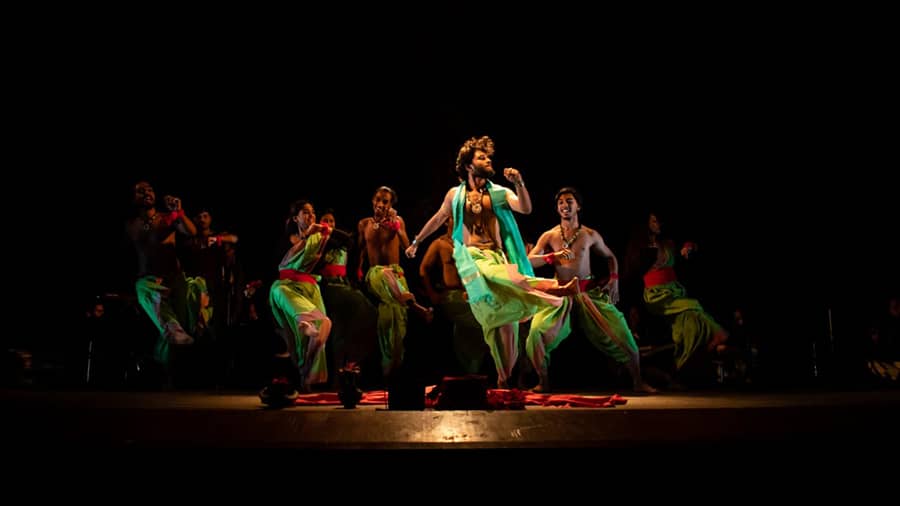Kolkata bore witness to an all-night theatre experience as director Manish Mitra's group Kasba Arghya performed their hit Mahabharata-themed play Urubhangam, which began at 11pm one Saturday night and ended in the wee hours of Sunday morning.
“I feel arrogant belonging to a city where people will stay up overnight to watch a play for seven hours,” the 55-year-old director said in his rousing introduction to the audience.
Urubhangam drew its themes of “the growth of a power structure, the Kuru dynasty, and how it came crashing down” from Bhasa’s Sanskrit play of the same name, Mitra told My Kolkata. Bhasa’s play revolved around Duryodhana’s introspection about the Mahabharata war and his action after Bhim broke his thighs and he lay defeated in the battlefield.

‘Urubhangam’ drew its themes of “the growth of a power structure, the Kuru dynasty, and how it came crashing down
An immersive experience
Mitra’s play, however, is a concise version of the Mahabharata that begins with the aftermath of the war and goes into flashback mode detailing the rise and fall of the Kuru dynasty.
The lawns of the Academy of Fine Arts came alive on the night of November 19, as Urubhangam audaciously began outside the auditorium. Crowds thronged to watch (and record on their smartphones) a live musical performance that set the mood for the play to unfold inside the proscenium.
This was in line with Mitra’s aim to create a 360-degree experience that grabs the audience’s attention in the open air and doesn’t let it slip even during the four intervals. For instance, one interval had actor Seema Ghosh, playing Gandhari, perform Pandavani, a Chhattisgarh-based folk-singing style of narrating stories from the Mahabharata.

Another scene from the play
“The proscenium-style theatre is a Western model while much of Indian theatre is rooted in performing outdoors,” Mitra explained. “While Western theatre is all about anukirtan, or telling stories through words, I wanted to explore bhavanukirtan, or mood. Because Indian theatre is where the performer can use the entire body, I eliminated lavish scenography or lighting.”

‘While Western theatre is all about anukirtan, or telling stories through words, I wanted to explore bhavanukirtan, or mood,’ said director Manish Mitra
So, unlike Peter Brook’s acclaimed Mahabharata play, where actors enacted roles and spoke dialogue, Mitra’s play featured performers playing multiple roles at a time and communicating the story through vigorous movement accompanied by musicians playing the sarod, flute and tabla to express the “rasas” and the “bhavas” accordingly, Mitra explained.
The songs, in Sanskrit, Hindi, and Bengali, were based on the original Mahabharata shlokas. Abhijit Chakraborty, Rupak Dey and Niloy Chakraborty composed the music. The performers’ dance was not “choreographed”, a word Mitra hates, but a “response to the music, emerging internally”.
‘A rich and living oral epic’
So, why Mahabharata? Mitra had zeroed in on Bhasa’s Urubhangam “to create an entirely Indian-style play, drawing from ancient theatre practices such as Kerala’s Koodiyattam,” he explained. His travels across India to research on different styles of performing Mahabharata led him to coastal-belt Karnataka’s Yakshagaana theatre, and Tamil street-theatre form Therekoothu.
The final play combined various folk traditions, leading to its multilingual and pan-Indian nature. The November 18 performance featured a mix of Bengali, Sanskrit and English dialogue with a pinch of Chhattisgarhi and Hindi. “Mahabharata is, after all, not just Vyas’s Sanskrit text,” Mitra said. “It’s a rich and living oral epic.”

The play combined various folk traditions, leading to its multilingual and pan-Indian nature
Thanks to Mitra’s interest in alternative ways of performing Mahabharata, the Tamil village deity Iravan, a figure chiefly worshipped by the local transgender community, took up a chunk of the final chapter in Saturday’s play.
“Since my play is an examination of power structure, Iravan allowed me to explore power structures within gender issues,” Mitra explained.
Mitra also drew from several Mahabharata-related texts such as Dharamvir Bharati’s Hindi play Andhayug, Bratya Basu’s Bengali play Jatugriha, SL Bhyrappa’s Kannada novel Parva, Shivaji Sawant’s Marathi novel Mrityunjay, MT Vasudevan Nair’s novel Randamoozham, and Devdutt Pattanaik’s illustrated book Jaya.
Among the highlights of the eye-popping performance was Mitra’s performance as the vidushaka, or jester, offering social critique of the play’s events (“Why did Kunti ask all his sons to marry Draupadi, and why did Draupadi accept it?” he wondered), as well as interacting with the audience.

The play featured performers playing multiple roles at a time and communicating the story through vigorous movement accompanied by music
At one point, he quizzed the audience, “So much for watching Mahabharata… tell me who was Dhrishtadyumna?” One lone voice managed to answer correctly: Draupadi’s brother.
Isn’t he confounded by the simultaneous ignorance and enthusiasm in the audience about Mahabharata?
“Unfortunately, most Bengali audiences recognise BR Chopra’s Mahabharata television serial as the official version,” he said. “However, Bengalis do have the curiosity to learn and know more. It’s true that with most Bengali plays today, the audience can’t wait to use their phone during the interval, or eat cutlets. That is why my aim was to not just create a play, but an experience.”
